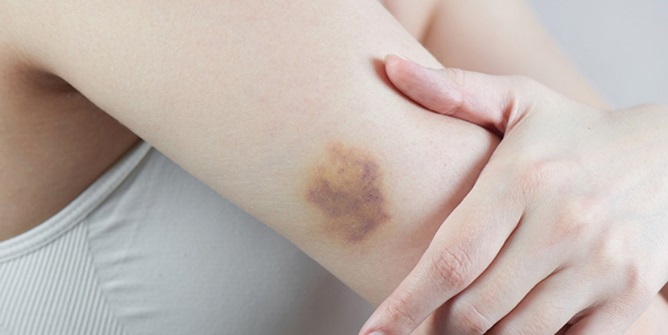
What You Should Know About Hematomas
Bruises and hematomas are similar, but they have some important differences. See what causes hematomas, what makes them unique, and how you can spot them.
by: Author: Michael Hickey
People with bleeding disorders are familiar with bruises, but similar situations that cause bruising can also cause hematomas. While similar, hematomas and bruises aren’t exactly the same. Here’s a look at hematomas, what they are, how people get them, how they are treated, and what risks they pose to people with hemophilia and other bleeding disorders.
What Is a Hematoma?
A hematoma is a collection of blood outside the blood vessels that causes pain and swelling, and disfiguring bruises. Some hematomas can affect internal organs, damage your skin and tissue, and be severe enough to require medical attention.
Hematomas can result from an injury to any type of blood vessel, such as arteries, veins or small capillaries. Hematomas are caused by traumas such as car accidents, head injuries, falls, aneurysms and bone fractures. Certain medical conditions such as hemophilia, blood cancers and liver disease increase the risk of developing hematomas.
There are several types of hematomas, differentiated based on their location in the body. A subdermal hematoma is located under the skin, while an intramuscular hematoma is located inside muscle tissue.
What Are the Signs and Symptoms of a Hematoma?
While symptoms depend on the size and location, hematomas often cause pain, swelling and redness; they can also make the skin feel spongy, rubbery or lumpy. Superficial hematomas can be visible under the surface of the skin or nails, while deeper hematomas may not be visible.
Additional symptoms and types of hematomas depend on their location in the body.
- A subdural hematoma—a buildup of blood on the surface of the brain—can cause headaches, confusion, dizziness and vomiting.
- An epidural hematoma—an accumulation of blood between the skull and the dura, which is the membrane covering the brain—can cause weakness, confusion and drowsiness.
- A subungual hematoma—blood that is trapped under the nail after trauma—can cause throbbing pain, turn your nail black and blue, and give you the feeling that there is pressure under the nail.
- A hepatic hematoma—located within the liver—can cause abdominal pain, nausea and the feeling of being full even after eating very little. But deep hematomas such as these may not have any symptoms at all, and could only be diagnosed through an imaging test such as a CT scan or MRI.
What Are the Differences Between Bruises and Hematomas?
Bruises develop when small blood vessels are injured and leak blood into tissues under the skin. But hematomas are larger leaks from larger blood vessels, which cause the blood to pool, and can be deeper in the body than bruises.
Hematomas and bruises have slightly different qualities: a bruise is flat and causes the injured area on the skin to turn black and blue. Meanwhile, a hematoma, if superficial enough to be visible, creates a painful, lump on the skin that can be red, black, blue or purple.
The severity and longevity of hematomas also separate them from bruises. While most bruises fade away within a couple of days to weeks, hematomas may last a month or longer. Hematomas may also come with more severe, long-lasting pain than bruises.
How Is a Hematoma Treated?
Most hematomas disappear on their own and need no evaluation. Hematomas that are just under the skin can be treated with the same home remedies you would use on a regular bruise, such as resting, icing the injured area, elevating the injured area, and adding a compress such as elastic bandages.
However, deeper hematomas, such as subdural or epidural, may need further evaluation. Anyone who develops symptoms such as confusion, intense headache or any other neurological symptoms after trauma should seek medical care immediately.
Source: HemaWare, October 2021